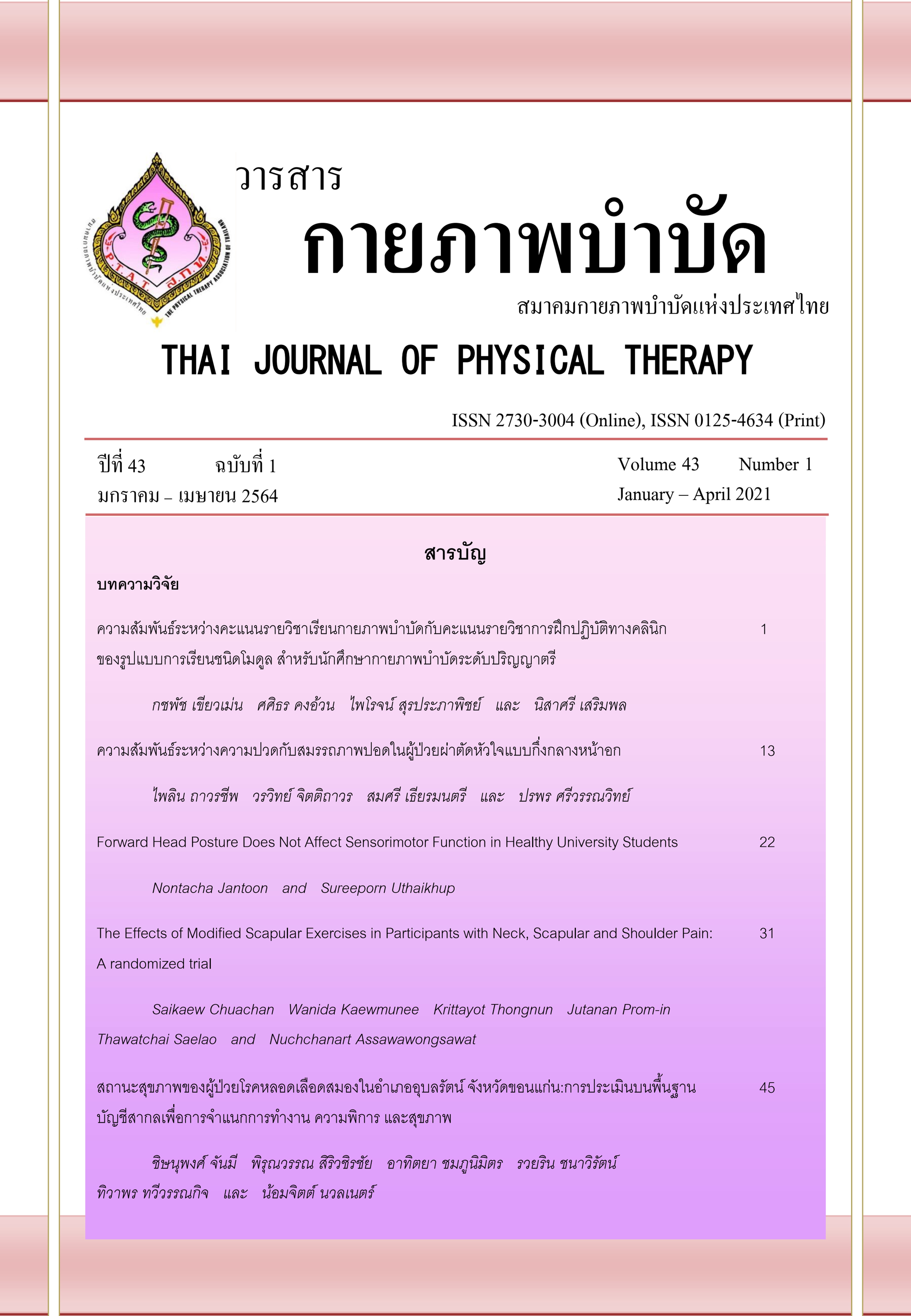ท่าทางศีรษะยื่นไปข้างหน้าไม่ส่งผลต่อการทำงานด้านการรับรู้และสั่งการในผู้ใหญ่ตอนต้นที่มีสุขภาพดี
Main Article Content
บทคัดย่อ
ที่มาและความสำคัญ: ท่าทางของศีรษะยื่นไปข้างหน้าถูกพบว่ามีผลต่อการทำงานด้านการรับรู้และสั่งการ อย่างไรก็ตาม ผลกระทบของศีรษะยื่นไปข้างหน้าต่อการรับรู้ตำแหน่งของกระดูกสันหลังส่วนคอและการทรงท่ายังไม่ทราบชัดเจน
วัตถุประสงค์: เพื่อศึกษาผลของท่าทางของศีรษะยื่นไปข้างหน้าต่อการรับรู้ตำแหน่งของกระดูกสันหลังส่วนคอและการทรงตัวขณะยืนในนักศึกษามหาวิทยาลัยที่มีสุขภาพดี
วิธีการวิจัย: อาสาสมัครประกอบด้วยนักศึกษามหาวิทยาลัยจำนวน 60 คน (30 คนมีท่าทางของศีรษะยื่นไปข้างหน้า และ 30 คนมีท่าทางของศีรษะปกติ) ช่วงอายุระหว่าง 19 ถึง 24 ปี ท่าทางของศีรษะยื่นไปข้างหน้าถูกคัดกรองด้วยการวัดมุมการยื่นของคอ (craniovertebral angle, CV angle) โดยมุมการยื่นของคอ ≤ 48 องศาถูกพิจารณาว่ามีท่าทางของศีรษะยื่นไปข้างหน้า การรับรู้ตำแหน่งของกระดูกสันหลังส่วนคอวัดโดยใช้เลเซอร์ที่ติดอยู่เหนือศีรษะในทิศทางเงยคอ และหมุนคอไปทางด้านซ้ายและขวา การทรงตัวขณะยืนวัดโดยใช้อุปกรณ์วัดการแกว่งของร่างกาย (sway meter) ใน 2 เงื่อนไข คือ ยืนเท้าชิดพร้อมกับลืมตาและหลับตา ตัวแปรที่วัด ได้แก่ ความคลาดเคลื่อนของการรับรู้ตำแหน่งของคอ และพื้นที่การแกว่งของร่างกายและระยะการแกว่งของร่างกายในทิศทางด้าน-หลัง และซ้าย-ขวา
ผลการวิจัย: ไม่พบความแตกต่างอย่างมีนัยสำคัญระหว่างกลุ่มของความคลาดเคลื่อนของการรับรู้ตำแหน่งของคอในทุกทิศทาง (ทั้งหมด p > 0.05) พื้นที่ของการแกว่งของร่างกายและการแกว่งของร่างกายในทิศทางด้านหน้า-หลัง และซ้าย-ขวา ขณะยืนลืมตา-หลับตา ไม่ถูกพบความแตกต่างอย่างมีนัยสำคัญทางสถิติระหว่างสองกลุ่ม (ทั้งหมด p > 0.05)
สรุปผล: ท่าทางศีรษะยื่นไปข้างหน้าไม่มีผลต่อการรับรู้ตำแหน่งของกระดูกสันหลังส่วนคอและการทรงตัวในท่ายืนในนักศึกษามหาวิทยาลัยที่มีสุขภาพดี ผลการศึกษานี้อาจจะแสดงให้เห็นว่าท่าทางศีรษะยื่นไปข้างหน้าไม่ได้ส่งผลต่อการประมวลผลของระบบการทำงานของการรับรู้และการสั่งการ
Article Details
เอกสารอ้างอิง
Grimmer-Somers K, Milanese S, Louw Q. Measurement of cervical posture in the sagittal Plane. J Manipulative Physiol Ther. 2008;31(7):509-17.
Griegel-Morris P, Larson K, Mueller-Klaus K, Oatis CA. Incidence of common postural abnormalities in the cervical, shoulder, and thoracic regions and their association with pain in two age groups of healthy subjects. Phys Ther. 1992;72(6):425-31.
Edmondston SJ, Sharp M, Symes A, Alhabib N, Allison GT. Changes in mechanical load and extensor muscle activity in the cervico-thoracic spine induced by sitting posture modification. Ergonomics. 2011;54(2):179-86.
Nejati P, Lotfian S, Moezy A, Nejati M. The study of correlation between forward head posture and neck pain in Iranian office workers. Int J Occup Med Environ Health. 2015;28(2):295-303.
Silva AG, Punt TD, Sharples P, Vilas-Boas JP, Johnson MI. Head posture and neck pain of chronic nontraumatic origin: a comparison between patients and pain-free persons. Arch Phys Med Rehabil. 2009;90(4):669-74.
Yip CH, Chiu TT, Poon AT. The relationship between head posture and severity and disability of patients with neck pain. Man Ther. 2008;13(2):148-54.
Quek J, Pua YH, Clark RA, Bryant AL. Effects of thoracic kyphosis and forward head posture on cervical range of motion in older adults. Man Ther. 2013;18(1):65-71.
Mousavi-khatir R, Talebian S, Maroufi N, Olyaie G. Effect of static neck flexion in cervical flexion-relaxation phenomenon in healthy males and females. J Bodyw Mov Ther. 2015;20(2):235-42.
Shimaa T. Abu El Kasem OMK, Neveen A. Abdel Raoof, Ibrahim M. Moustafa. Effect of forward head posture on sensorimotor integration. Int J Phys Ther. 2017;4(2):118-25.
Mayoux-Benhamou MA, Revel M, Vallee C, Roudier R, Barbet JP, Bargy F. Longus colli has a postural function on cervical curvature. Surg Radiol Anat. 1994;16(4):367-71.
Boyd-Clark LC, Briggs CA, Galea MP. Muscle spindle distribution, morphology, and density in longus colli and multifidus muscles of the cervical spine. Spine J. 2002;27(7):694-701.
Liu JX, Thornell LE, Pedrosa-Domellof F. Muscle spindles in the deep muscles of the human neck: a morphological and immunocytochemical study. J Histochem Cytochem. 2003;51(2):175-86.
Goh JYK, O’Leary S, Chow A, Russell T, McPhail S. The relationship between forward head posture and cervical muscle performance in healthy individuals. J Physiother. 2015. doi: 10.1016/j.physio.2015.03.3247
Kang JH, Park RY, Lee SJ, Kim JY, Yoon SR, Jung KI. The effect of the forward head posture on postural balance in long time computer based worker. Ann Rehabil Med. 2012;36(1):98-104.
Silva AG, Johnson MI. Does forward head posture affect postural control in human healthy volunteers? Gait Posture. 2013;38(2):352-3.
Hickey ER, Rondeau MJ, Corrente JR, Abysalh J, Seymour CJ. Reliability of the cervical range of motion (CROM) device and plumb-line techniques in measuring resting head posture (RHP). J Man Manip Ther. 2000;8(1):10-7.
Hazar Z, Karabicak GO, Tiftikci U. Reliability of photographic posture analysis of adolescents. J Phys Ther Sci. 2015;27(10):3123-6.
Ruivo RM, Pezarat-Correia P, Carita AI. Cervical and shoulder postural assessment of adolescents between 15 and 17 years old and association with upper quadrant pain. Braz J Phys Ther. 2014;18(4):364-71.
Revel M, Andre-Deshays C, Minguet M. Cervicocephalic kinesthetic sensibility in patients with cervical pain. Arch Phys Med Rehabil. 1991;72(5):288-91.
Lord SR, Clark RD, Webster IW. Postural stability and associated physiological factors in a population of aged persons. J Gerontol. 1991;46(3):69-76.
Lord SR, Menz HB, Tiedemann A. A physiological profile approach to falls risk assessment and prevention. Phys Ther. 2003;83(3):237-52.
De-la-Llave-Rincon AI, Fernandez-de-las-Penas C, Palacios-Cena D, Cleland JA. Increased forward head posture and restricted cervical range of motion in patients with carpal tunnel syndrome. J Orthop Sports Phys Ther. 2009;39(9):658-64.
Manchester D, Woollacott M, Zederbauer-Hylton N, Marin O. Visual, vestibular and somatosensory contributions to balance control in the older adult. J Gerontol. 1989;44(4):118-27.
Kristjansson E, Treleaven J. Sensorimotor function and dizziness in neck pain: implications for assessment and management. J Orthop Sports Phys Ther. 2009;39(5):364-77.
Dolan KJ, Green A. Lumbar spine reposition sense: the effect of a 'slouched' posture. Man Ther. 2006;11(3):202-7.
Paulus I, Brumagne S. Altered interpretation of neck proprioceptive signals in persons with subclinical recurrent neck pain. J Rehabil Med. 2008;40(6):426-32.
Uremovic M, Cvijetic S, Pasic MB, Seric V, Vidrih B, Demarin V. Impairment of proprioception after whiplash injury. Coll Antropol. 2007;31(3):823-7.


